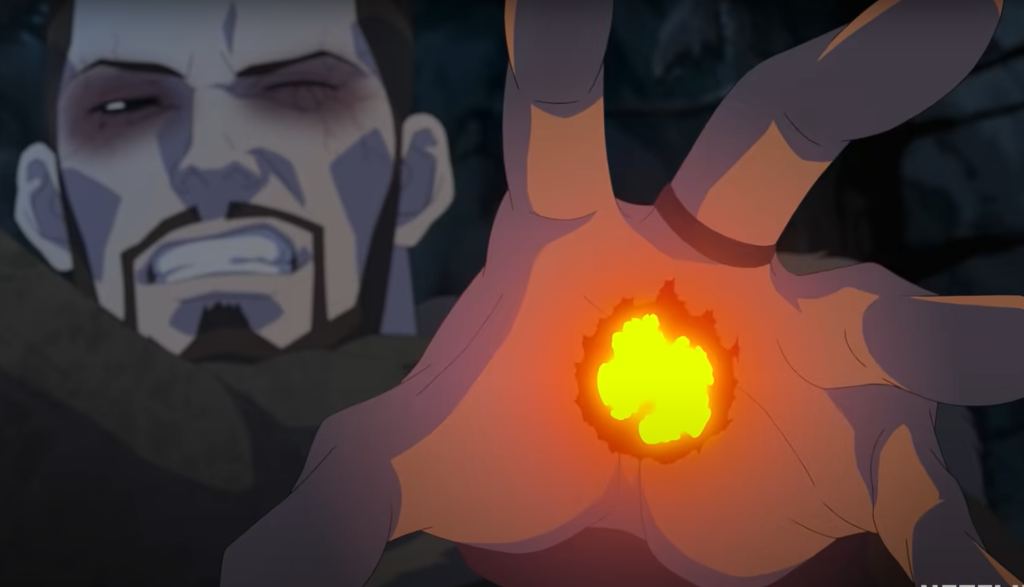
“Witchers are rogues without virtue. True diabolical creatures, fit only for killing. There is no place amidst honest men for them.”
Or so it is according to Tetra Gilchrist, a mage claiming to be a descendant of the first mages to inhabit the lands of Kaedwen.
Alas, Tetra and the rest of the world are stuck with them for now. They’re the only creatures capable of killing the monsters that roam the land. But if Tetra had her druthers, she’d wipe the earth clean of all these monster-human hybrids called witchers. And it doesn’t help that witchers have a bad reputation for swindling innocent people out of their money…
Take Vesemir, for instance. He voluntarily joined the witchers when he was a child, searching for adventure and glory. Now, he’s known as a “swashbuckling witcher for hire, priced only for the foulest of creatures.”
Vesemir certainly found the adventure—after all, there’s always another monster—but the glory? Not so much. But when a new hybrid monster starts slaughtering the people of Kaedwen, it’ll require some cooperation between Vesemir and Tetra to rid the land of this foul beast.
Vesemir goes through quite the character development. He starts off as a man who kills for fun and for money. But as he uncovers secrets both about humans and witchers, Vesemir realizes that life is precious, and saving one shouldn’t be a luxury that onlythe rich and powerful can afford. He starts to defend the weak and takes action to end the corruption within the witcher order.
His mentor, Deglan, also has a character transformation—though we don’t see it take place on screen the same way as Vesemir. Originally a man who would con innocent people out of their coin, he stops caring about the money and takes measures to preserve the witcher order. And though his methods are still lacking, he charges Vesemir with raising up the next generation of witchers to be “better men.”
We learn that a wealthy woman turned her husband’s estate into an orphanage after he passed away.
Mages and witchers alike can cast spells—some for good and some for evil. But purists, like Tetra, consider the creation of witchers through alchemy (a blend of science and magic) to be a dark and blasphemous ritual. Tetra believes that witchers are staging monster attacks to make a quick coin. So she wants to wipe out their order and the mages who assist them.
An elven woman named Kitsu is crossbred with a monster to give her incredible powers of illusion. She uses this power to control creatures and to trick Vesemir into killing his friend. Other monsters can shape-shift and possess people.
We hear about other instances of alchemy. It is suggested that necromancy plays a part in the creation of witchers (and Vesemir’s friend tells him to find his “rebirth”). Witchers wear medallions that vibrate and hum when monsters are near. They sometimes drink a potion to amp up their abilities (it turns their eyes and veins black). Someone tells a story about a witcher who tricked a priest into believing a sorceress had cursed him. A witcher performs an exorcism on a woman. A boy sings a song about an enchanted bracelet. Use of the term “gods” suggests Kaedwen is a pagan society.
We see the animated bodies of several naked people. One male witcher makes suggestive comments to a few other men (and says he wants to hire a “man-whore”). Tetra suggests that a woman earned her station in court through sex. There is a joke about sex. We hear a crude reference to male genitals. A couple kisses a few times.
A witcher’s sole purpose in life is to rid the land of the monsters. And they do so with an eagerness that suggests they enjoy killing more than helping people.
People are quite literally ripped apart by monsters—including several children. And despite being animated, the blood and gore we see here (e.g., some bodies are decapitated, others have organs hanging loose) is quite unsettling. The witchers do their part to destroy these creatures, slicing and dicing with their swords, knives and magic, but even then, they’re sometimes overrun.
But the witchers don’t limit themselves to just killing monsters. We hear that one witcher collected a bounty by killing an unfaithful husband. Others take up jobs as mercenaries for the better pay. And when two knights pick a fight with Vesemir and his buddy in a pub, the witchers kill them.
Mages and witchers go to war (with the former backed up by armed guards and a mob of villagers). We see the remnants of previous wars between humans and elves, in which the elves were decimated (and we learn dwarves have also been destroyed by humans). In the ruins of an elven city, we see several elven skeletons with swords still sticking out of them. Tetra tries to kill a young elven girl because the girl was turned into a hybrid (an elven man takes an arrow to the hand to protect the girl).
We learn that Kitsu kidnapped and experimented on dozens of other elven girls in her attempt to create more hybrids like herself. Unfortunately, all but one of these girls died during experimentation, and Vesemir’s elven friend, Filavandrel, is angry at him for not helping to find the girls sooner.
Several witcher recruits (young boys taken from their homes at a young age) are killed during the training trials. Furthermore, the process that creates a witcher involves killing the person with poison before bringing them back to life.
We hear a song about a bandit who killed a man for a monster-repelling bracelet. Some children play near the corpse of a dead wolf. Vesemir learns that his father was killed while trying to save a lord and lady (who were also killed). Some characters exchange death threats. In a dream, Vesemir’s friends drink blood from goblets. A witcher is wrongfully beheaded for crimes he didn’t commit. Someone says that certain towns cut off the hands of thieves and force them to wear the limbs around their necks as punishment.
We hear two uses of the f-word and one of the s-word. We also hear uses of “a–,” “b–tard,” “c–k,” “h—” and “p-ss.” There is one misuse of God’s name, although proceeding uses of “gods” suggests that it is a reference to a pagan god, not the Christian one.
People drink throughout the movie.
Witchers are hated for being “mutants” with supernatural powers. And while most people are grateful for their services, they also fear them.
We see that Tetra’s accusations of corruption against the witchers are accurate. Deglan says that “fear and ignorance” are good for business, and he uses it to his advantage first to con people out of their money and later to scare people into believing that monsters are getting more dangerous, thereby increasing the need for witchers.
We hear a story about a witcher who paid a man’s cook to poison his food. The witcher convinced the sick man that his illness was the result of a curse and that the curse could be broken by killing the one who cast it. The witcher then killed an innocent sorceress to “cure” the man (and we later learn the witcher knew the sorceress’s young daughter was hiding and watching).
And although this might have been an isolated incident, Vesemir says it was a “good con” and wishes he had thought of it himself. He loots the corpses of a young boy’s family after saving the boy from a monster. He then refuses to help bury the bodies or even accompany the boy to the next town.
Witchers are also cruel towards their trainees. Most of the boys are given to the witchers as payment. But rather than offer them comfort, the witchers starve the abandoned children and deprive them of sleep. They then put them through harsh trials, which many don’t survive.
Tetra and her mages are no better. Deglan states that because humans live such short lives, they spend it fearing and hating others. And we see evidence of this hatred since mages literally created monsters to wipe out elves and other races. Ironically, when they couldn’t control the monsters, they then created witchers to hunt them down (but still condemned them as mutants since they feared the power of the witchers). And when Tetra criticizes Vesemir’s morality, he points out the hypocrisy.
A boy urinates. Someone makes a reference to excrement. Some characters vomit from illness. Another vomits while being exorcised. Two children blanche at a man’s odor.
Children steal. A man threatens to sell his servant’s son. A boy shows open disdain towards his father for being “meek and penniless.”
Anyone who has seen The Witcher Netflix series or played the video games or perhaps even read the original novels by Andrzej Sapkowski knows that the franchise isn’t a family-friendly fantasy tale.
Language in this anime film is harsh, with uses of the f-word. And nudity, though animated, is also present. Magic, including references to necromancy, is ever-present.
But violence is perhaps the most obvious issue since witchers are literally monster-hunters. However, we also see how humans are just as bad (if not worse) than witchers.
It was human mages who created monsters to kill elves and other races for food and land. But when they couldn’t control the beasts, they created the witchers to hunt them down—and then condemned witchers for being mutants.
That isn’t to say that witchers aren’t bad either. Filavandrel tells Vesemir, “Imagine if you witchers labored for more than just thrill and coin.”
In truth, the world of Kaedwen could probably be a better place with a little more mutual understanding. In the pagan world we’re given here, perhaps the witchers would be less greedy if they were shown a little more grace, and more innocent people would be saved from monsters.
Unfortunately, none of that really matters. Because even if witchers were the “better men” that Deglan hoped for, The Witcher: Nightmare of the Wolf would probably still be unwatchable since monsters and witchers would still be slaughtering each other left and right.


Emily studied film and writing when she was in college. And when she isn’t being way too competitive while playing board games, she enjoys food, sleep, and geeking out with her husband indulging in their “nerdoms,” which is the collective fan cultures of everything they love, such as Star Wars, Star Trek, Stargate and Lord of the Rings.